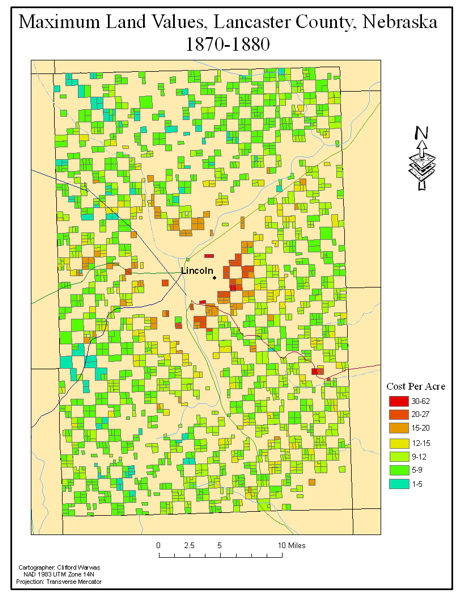Land Sales in Nebraska: Comparing Two Nebraska Counties on the Burlington Railroad
- Lancaster and Clay County Land Sales, 1870-1880 Dynamic Map
- Ethnicity in Olive Branch Township, NE
- Nebraska Railroad Expansion, 1865-1886 Animation
- Maximum Land Values, Lancaster County, Nebraska, 1870-1880
- Native-Born Clustering in Lynn Township, NE
- Growth of the Railroad in Clay County, NE
- Growth of the Railroad in Lancaster County, NE
Maximum Land Values, Lancaster County, Nebraska, 1870-1880

Keywords
- Category: Historical GIS Images
The Burlington Railroad encouraged and achieved rapid colonization of its estates in Nebraska. Settlement patterns were remarkably diffuse within these areas, and migrants from all over the United States lived next to immigrants from numerous places in almost every 640 acre section of the land grant. This diversity was realized because the company had an opened-ended land-contract policy, and because settlers took up the technology the railroads made possible and used it to their own purposes. Indeed, the colonizers – wherever they started from -- made a host of decisions and evaluations that shaped Nebraska and its landscape. At first glance, their purposes appear straightforward -- to start a homestead, to own land, to speculate on lots. On closer inspection, however, a number of patterns become visible and reveal a more complex story. The consequences of the railroad and its land settlement policies were more dynamic and widely felt than the story of economic development alone suggests.
Rather than lured to the Plains by duplicitous land agents or trapped in culturally restricted enclaves after arrival, the settlers who purchased railroad lands took part in a modern process of mobility and movement, one that shaped the unique cultural pluralism of the Great Plains. On the one hand, many individuals responded to recruitment literature that was distributed all over the eastern United States and most of Europe and purchased railroad acreage according to a “modern” settlement model. These immigrants primarily sought economic advantages in an increasingly commercialized agricultural society. They were informed of prospective business opportunities by “mass or public information.” But as it turned out, agrarian entrepreneurs were joined by others that arrived using an older “community” pattern of settlement. These agriculturalists organized their movements around tried and true kinship networks, and they often moved as communities in a process that was relatively closed to outsiders. Their tendency during the 1870s and 1880s was to congregate in “ethnic islands” and migrant clusters. The confluence of these simultaneous and interrelated movements which the railroad made possible became one of the most surprising and defining characteristics of the land settlement process on the Great Plains.